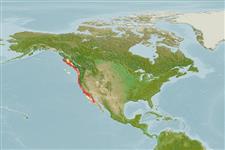>
Perciformes/Scorpaenoidei (Scorpionfishes) >
Sebastidae (Rockfishes, rockcods and thornyheads) > Sebastinae
Etymology: Sebastes: Greek, sebastes = august, venerable (Ref. 45335); aurora: From the 'aurora' meaning dawn - referring to the colouring (Ref. 6885).
Eponymy: Aurora was the Roman goddess of the dawn. In the case of the goby, the name refers to the pattern on its caudal fin being ‘…reminiscent of the rising sun’. The name is often applied to species with pink/yellow colouration. (Ref. 128868), visit book page.
More on author: Gilbert.
Environment: milieu / climate zone / depth range / distribution range
Écologie
marin bathydémersal; profondeur 124 - 769 m (Ref. 27437), usually 366 - 550 m (Ref. 6885). Deep-water; 56°N - 27°N, 135°W - 113°W
Northeast Pacific: Amphitrite Point in Vancouver Island, Canada to Cedros Island, Baja California, Mexico.
Length at first maturity / Taille / Poids / Âge
Maturity: Lm ?, range 28 - ? cm
Max length : 41.0 cm TL mâle / non sexé; (Ref. 27437); âge max. reporté: 75 années (Ref. 55644)
Description synthétique
Clés d'identification | Morphologie | Morphométrie
Épines dorsales (Total) : 13; Rayons mous dorsaux (Total) : 12 - 14; Épines anales: 3; Rayons mous anaux: 5 - 6. Head spines strong - nasal, preocular, supraocular, postocular, tympanic, parietal and nuchal spines present, coronals usually absent (Ref. 27437). Small lobes projecting from anterior part of upper jaw (Ref. 27437). Second anal fin spine long (Ref. 27437). Rose-red to pink dorsally, silvery on sides and ventrally (Ref. 27437).
Common offshore (Ref. 2850). Viviparous, with planktonic larvae and pelagic juveniles (Ref. 36715). Trawled on soft bottom and when caught scales usually rub off, leaving white pockets bordered by red; also caught in sablefish traps (Ref. 2850).
Eschmeyer, W.N., E.S. Herald and H. Hammann, 1983. A field guide to Pacific coast fishes of North America. Boston (MA, USA): Houghton Mifflin Company. xii+336 p. (Ref. 2850)
Statut dans la liste rouge de l'IUCN (Ref. 130435: Version 2024-1)
Menace pour l'homme
Harmless
Utilisations par l'homme
Pêcheries: commercial
Outils
Articles particuliers
Télécharger en XML
Sources Internet
Estimates based on models
Preferred temperature (Ref.
123201): 4.5 - 7.5, mean 5.4 °C (based on 15 cells).
Phylogenetic diversity index (Ref.
82804): PD
50 = 0.5000 [Uniqueness, from 0.5 = low to 2.0 = high].
Bayesian length-weight: a=0.00389 (0.00180 - 0.00842), b=3.12 (2.94 - 3.30), in cm total length, based on all LWR estimates for this body shape (Ref.
93245).
Niveau trophique (Ref.
69278): 3.7 ±0.5 se; based on size and trophs of closest relatives
Résilience (Ref.
120179): Très faible, temps minimum de doublement de population supérieur à 14 ans (tmax=75; tm=5).
Prior r = 0.03, 95% CL = 0.02 - 0.04, Based on 1 full stock assessment.
Fishing Vulnerability (Ref.
59153): Low to moderate vulnerability (31 of 100).
